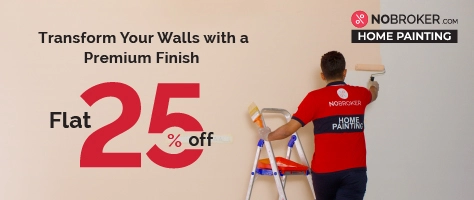I am a painting contractor and I can tell you how to paint stucco wall. Painting stucco walls involves a few specific steps to ensure a smooth and durable finish. Here’s how I approach it based on my experience.
How do You Paint Stucco Walls?
I start by cleaning the stucco surface thoroughly. I then use a pressure washer to remove dirt, dust, and loose paint.
Once the surface is completely dry, I inspect the stucco for any cracks or damage. I fill small cracks with a stucco repair compound. For larger cracks, I use a patching compound, applying it with a putty knife and smoothing it out. Once dry, I sand the patched areas to make them level with the rest of the wall.
Then I apply a primer to the stucco surface. I use a roller with a thick nap for even coverage. I allow the primer to dry.
Moving ahead, I choose a high-quality exterior acrylic paint designed for stucco. Apply the paint using a roller with a thick nap starting from the top and working my way down to avoid drips. For a uniform finish, I apply two coats, allowing each coat to dry completely before applying the next.
After the final coat is dry, I inspect the wall for any missed spots and paint them up as needed.
By following these steps, you can achieve an attractive finish for your stucco walls. If it seems a bit difficult you can also hire a professional. I hope this helps you understand how to paint exterior stucco walls, and interior stucco walls.
Get 1-Year Service Warranty & Quality Service Guaranteed Via NoBroker Painting ServiceRead More
How to Cover Interior Stucco Walls?
Shifting, House?
✔
Lowest Price Quote✔
Safe Relocation✔
Professional Labour✔
Timely Pickup & Delivery
Intercity Shifting-Upto 25% Off
Check Prices

Intracity Shifting-Upto 25% Off
Check Prices

City Tempo-Upto 50% Off
Book Now
Hi Buddy,
I work for a painting company. I collaborate with a group of painters and interior designers. A few days ago, we received a contract for a stucco paint finish on a client’s interior walls.
Take use of NoBroker's experienced painters to easily paint your stucco walls!From my work experience, I would like to highlight that no matter what style of property you have, a stucco paint interior treatment will make it look elegant and classy. However, it, like other finishes, loses its attractiveness over time. It could be re-dashed (adding a layer of stucco to the existing surface), but painting it is a cheaper and easier option.
How to paint stucco walls interior:I have observed how painters paint the stucco walls. It is indeed a laborious job. However, due to my recent experience with the same, I would like to brief you about the steps that our painters followed while undergoing the stucco paint interior treatment.
- Examine the Residence
Check the condition of the stucco before painting. Are there any flaws? Hairline cracks are common and are usually patched with paint. Stress cracks that flow toward the ground from the corners of windows and doors are also prevalent. They develop over time as a result of settling and can be rectified.
If you notice other indicators of deterioration, such as horizontal cracks, huge sections of stucco missing, or peculiar colouring, it could indicate a more significant problem, such as moisture behind the stucco. Hold off on painting until a stucco contractor can analyse the problem
- House Pressure Washing
Before painting, the stucco should be free of dirt and debris. It may be cleaned quickly and effectively with pressure washing.
If you don't possess a pressure washer, you can rent one. If you want to use a detergent, choose one that is environmentally friendly and mild. If you're not confident doing it yourself, hire a professional. Before continuing, the house should be entirely dry after it has been washed
- Stucco preparation
Use external acrylic caulk to repair tiny cracks and holes. Stucco patch can be used to fix larger cracks or damaged areas. If the stucco was previously painted, lightly sand the borders of the chipped areas with 80- or 100-grit sandpaper to remove any loose paint.
Try to detect if water has gotten under the stucco and if there is evidence of water leaking from a gutter and running down the side of the stucco (check for discolouration or degraded stucco). If it hasn't already, fix the gutter leak before painting. If you suspect it has, contact a professional to examine and fix the damage
Check out NoBroker plumbing services, in case you need any kind of help with repairing water leakage before stucco wall painting.- Select your paint colour
Acrylic latex paint with a flat gloss is appropriate for stucco. Because stucco is porous and needs to breathe, acrylic is an excellent choice. As a result, the paint you use must also breathe. Acrylic latex is simple to work with and cleans up easily.
Keep in mind that stucco walls will require more paint than other siding types. Because stucco is porous and has a rough texture, this is the case
- If necessary, prime the stucco
If you're painting the stucco for the first time, use an acrylic latex block filler to prime the walls first.
Stucco absorbs a lot of water. An acrylic latex block filler will soak into some of the stucco pores, allowing you to get the most coverage out of your finish. For application, follow the manufacturer's instructions
- Paint the room
With a brush, cut in around the windows, doors, and any trim. Then, using a thick-napped roller cover, roll paint on the walls. To keep a moist edge, start at the top and work in small portions.
Alternatively, you can use an airless sprayer to apply the paint. If the stucco is very textured, roll over the paint after spraying (AKA back-rolling).
You'll probably only need one topcoat if you prime the walls. Otherwise, two coats may be required. Follow the paint manufacturer's instructions for application temperatures and when to apply a second coat
It's remarkable how much a fresh coat of stucco paint finish can rejuvenate an old, dusty stucco surface. A good exterior paint job should last 15 to 20 years, while an interior paint job should endure until the style changes and you are wary of the colour. So take advantage of it while it lasts!
Assist yourself with the expert electrician service from NoBroker to help you out with any electrical issue.Read More:
How To Paint Textured Walls?Shifting, House?
✔
Lowest Price Quote✔
Safe Relocation✔
Professional Labour✔
Timely Pickup & Delivery
Intercity Shifting-Upto 25% Off
Check Prices

Intracity Shifting-Upto 25% Off
Check Prices

City Tempo-Upto 50% Off
Book Now
Related Questions
Related Questions in Generic Painting
Most Viewed Questions
Recently Published Questions
Authors Of The Question

0 Total Answers






How to Paint Stucco Walls?
Dhiman
294Views
2 Year
2022-05-25T11:29:45+00:00 2022-05-25T11:29:46+00:00Comment
2 Answers
Share